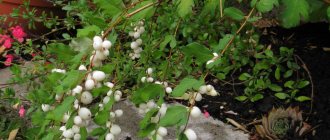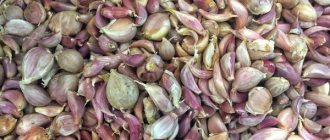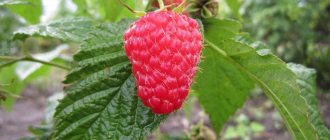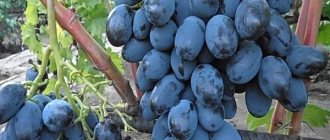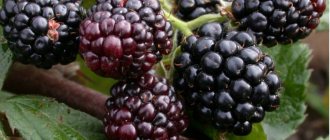Selection of planting material
Seedlings are selected from standard varietal plants. You will learn about the best gooseberry varieties for growing in this article.
In order for young gooseberries to take root, the following requirements are taken into account:
- the root system must have at least 3 skeletal roots 20-25 cm long;
- the above-ground part should contain 2-3 strong branches measuring about 30 cm;
- seedlings are selected without mechanical damage.
Plants with an open root system are taken without leaves (except for the top), and bushes with a closed root system, on the contrary, are taken leafy.
Plant diseases and pests
The greatest danger to gooseberries are fungal diseases, in particular powdery mildew or spheroteca. This fungus, which appeared in the north of America, is capable of destroying the entire crop, and if it is not dealt with, in a few years the entire plant may die. Only a few gooseberry varieties are immune to spheroteca.
Gooseberries affected by powdery mildew
Externally, this disease looks like a white coating that appears on leaves and fruits in late spring. After some time, this coating changes color and hardness, turning into a brown film.
To effectively combat this disease, fungicides, such as Topaz, are used. As a rule, a full cycle includes several treatments of the plant before and after flowering. For preventive purposes, gooseberries are processed the following year in April-May. You should strictly follow the instructions that come with the drug and not skip a single treatment throughout the entire cycle, otherwise you will have to face this problem again next year.
The main pests of the plant are aphids and gooseberry moth. As a result of aphid infestations, gooseberry leaves curl and shoots become bent. The berries of a plant attacked by aphids become small and often dry out before they have time to ripen.
The moth lays its eggs in the flowers of the plant and its caterpillars live in its fruits, eating their seeds.
Insecticides (for example, Fufanon) are used to control pests. However, it is better to take a number of preventive measures to avoid the possible consequences of an insect attack.
To do this you need to do the following:
- immediately after the snow melts, you need to cover the soil with dense material (for example, agrofibre) and sprinkle its edges with earth; in this way, it will be possible to get rid of fire butterflies crawling out of the ground; after flowering the cover can be removed
- Every autumn you should hill up the plants to a height of about 10 cm
- fruits damaged by caterpillars should be collected and destroyed
- It is recommended to spray the bushes with lepidocide immediately after flowering
Following these simple rules will help in the fight against major gooseberry pests.
Autumn planting
Autumn is a favorable time for planting. Over the winter the shrub will take root well and take root.
Optimal timing
Gooseberries are planted in late September - mid-October (depending on the climate). The event is held a month before the first sub-zero temperatures. The roots begin to go deeper into the soil at daytime temperatures of + 10...+15 C. In case of premature frosts, planting is postponed until spring, since the plant will not have time to take root and will freeze out.
Soil preparation
The shrub loves fertile, loose soil in well-lit, ventilated areas, but does not tolerate waterlogging. Therefore, it is not planted in wetlands and close to groundwater.
Gooseberry bushes prefer neutral or slightly acidic soil. If the soil is acidic, add limestone or dolomite flour. Before planting, the area is dug up and cleared of weeds.
You can determine the increased acidity of the soil as follows: if moss, sorrel, and horsetail grow on the site, the acidity is high.
In order for the soil to settle, holes are dug 2-3 weeks before planting. The optimal depth is 50-55 cm, width is 55-60 cm. The holes are filled 2/3 with fertilizers (superphosphate, ash, rotted manure).
Step-by-step recommendations for planting
Autumn planting of gooseberries is carried out in several steps:
- Inspect the bush for damage, remove unhealthy parts and broken roots with pruning shears.
- The plant is placed to a depth of no more than 5 cm at the root collar.
- Sprinkle the roots with soil so that there are no voids between them.
- Compact the soil with your feet (not too much) to secure the bush to the soil surface.
- The tree trunk circle is watered with 5 liters of water.
- Mulch the soil with peat or humus.
The seedlings are watered once every 4-5 days (if there is no rain).
10 days after planting, gardeners recommend treating the bushes against pests and fungi for prevention. In autumn, seedlings are not pruned.
In this video, the gardener shares his experience of planting gooseberries in the autumn:
Do I need to insulate for winter?
Gooseberries are a frost-resistant crop. Adult plants are not specially covered for the winter; snow cover is sufficient to retain heat. Seedlings, especially in regions where winters are cold, protect against freezing. Plants are covered with spruce branches, fallen leaves or agrofibre.
Features of gooseberries
Gooseberry is not a very large shrub, the height of which does not exceed 1.2 m. The peeling bark is colored brownish-gray. The plant has spines of leaf origin. On the surface of young cylindrical shoots there are thin needles - these are thorns. The petiolate, dull leaf blades are short-haired, they have a heart-shaped-ovate or rounded shape and a length of about 60 mm. The leaves are three to five lobed, with blunt teeth along the edge. Axillary pale red or light green flowers open in May. The fruits are spherical or oval-shaped berries, reaching 1.2 cm in length (in some varieties the berries are about 4 cm long), their surface can be bare or there are coarse bristles on it, and there are clearly visible venations. They can be white, green, yellow or red in color and ripen from June to August. The fruits of this bush are very tasty and healthy; they contain metal salts, vitamins, organic acids and tannins. This plant is an early honey plant; it helps attract a large number of pollinating insects to the garden plot. Gooseberries are self-fertile, so if you wish, you can plant just 1 bush in the garden, and it will produce a harvest.
Gooseberry. Gooseberry care. Planting gooseberries
Spring planting
In spring, gooseberries are planted before sap flow begins. If you neglect the deadlines, you may not wait for a bountiful harvest, the bush will grow weak.
Optimal timing
The favorable time for planting in spring depends on the region. In warm regions, gooseberries are planted in March, in the northern regions - until the end of April. Plant until the buds swell.
Soil preparation
It is better to fertilize the soil in the fall. In spring, it is difficult to apply fertilizers due to high soil moisture. The choice of planting site and soil acidity are no different from planting in the fall.
Gooseberries are not planted where raspberries, other varieties of gooseberries, and currants used to grow, since these plants are affected by common diseases and pests. Places where peas, potatoes, and beets grew are considered favorable for planting.
Step-by-step recommendations for planting
Spring planting of seedlings consists of the following steps:
- Seedlings are inspected for damage. Sick, dry, rotten roots are removed.
- The bushes are treated with a biostimulant solution (Zircon, Epin). This way the root system will take root better.
- In order for the root shoots to grow faster and take root, the plant is placed in the hole at an angle of 45 degrees.
- The soil around the seedling is compacted (not tightly) and watered with water.
- Aboveground shoots are cut to 15-20 cm, leaving 3-4 buds.
After planting, the bushes are watered once a week (until the roots are established). The tree trunk circle is regularly weeded. To protect against weeds, the soil is mulched with peat and leaves.
Watch the following video on how to plant gooseberries in spring:
Proper cultivation
Which place to choose? Be sure to be well-lit, preferably a small slope in the south-east direction, protected from cold winds. Good predecessors for it are vegetable plants that require careful care. High acidity of the soil is not a hindrance for gooseberries, but liming will not harm it.
How is the soil prepared? The same as for currants. But we must keep in mind that it needs potassium more than currants, so 8-10 kg of organic fertilizers, 100-120 g of granulated superphosphate, 80-100 g of potassium sulfide or ash per 2 m2 are added in advance for digging. Fertilizers are also applied to the planting hole: 8-10 kg of manure, 150-200 g of superphosphate, 40-60 g of potassium sulfate. There is no need to regret the costs, the return on them will be equivalent.
Landing. Autumn is the most favorable time to plant gooseberries. Spring planting is undesirable, because it begins to grow very early and does not take root well in the spring. From mid-September to mid-October is the most optimal time.
The holes are dug 30-40 cm deep and 50-60 cm in diameter. The roots of the seedlings are dipped in clay mash before planting. The branches of the seedlings are pruned, leaving 3-4 shoots with 4-5 buds on each. If there is a delay in planting, the seedlings are placed in water for 4-5 hours. After planting, the soil around the seedling is compacted and mulched with leaves, straw, peat, pine needles or sawdust in a layer of up to 10 cm.
Various ways to grow gooseberries
In addition to the usual bush formation, gooseberries are grown on a trunk and on a trellis. Let's consider these agricultural methods.
On the trellis
Growing berry bushes on a trellis has its advantages:
- evenly spaced branches of the bush increase illumination, which contributes to the smooth ripening of berries;
- vertical planting has a positive effect on the quality of the crop: the fruits grow large and sweet;
- bushes become less dirty and become infected with fungal infections.
Trellis - reinforced concrete, wooden, plastic pillars (pipes) about 2 m in size are placed on both sides of the row. Wire is stretched between the pillars at 3 levels. Several bushes (5-6) are planted at a distance of 0.5 to 1 m from each other, the branches are arranged in the shape of a fan. The plant is then tied to the bottom wire of the structure and directed vertically. Seedlings are pruned to 3-4 buds.
The shoots that have grown from the root collar are removed in the second year to form the shoot wall thickness and density. The lateral growths grown on the main bushes are shortened above the 5th leaf.
They care for the shrub as with normal planting: mulch, water, and trim. Fertilizers are applied in the spring.
Gooseberry without thorns
Breeders have developed thornless gooseberry varieties, which are in great demand among gardeners. These varieties are distinguished by early and rich fruiting. A good harvest is harvested in the second year after planting, and an adult shrub produces up to 1.5 kg of fruit.
The thornless gooseberry loves fertile soils. In the fall they fertilize with organic compounds, and in the spring with ammonium nitrate or urea.
The peculiarity of these varieties is that the bushes do not pollinate well, so they are planted at a distance of at least a meter from each other. Otherwise, planting and pruning plants is no different from other varieties.
Growing standard gooseberries
Gooseberry bushes arranged in a standard way not only serve as decoration for the garden, but also have their own advantages:
- the plant receives more light, due to which the berries ripen evenly and grow large and sweet;
- It is more convenient to harvest and care for shrubs in the form of a tree;
- In small areas, standard planting saves space.
Shrubs are grown using the standard method, both with and without grafting. A scion of golden currant is taken as a rootstock and cared for throughout the summer. To thicken the trunk, the apical shoots are removed. When the trunk is prepared, ripened gooseberry shoots are selected, thorns and leaves are removed. Then the shoot is shortened above the third bud and grafted using the “bark” method.
When grown without grafting, the above-ground branches of a strong gooseberry bush are cut off, leaving only one shoot to form the trunk. Side branches are periodically removed to a height of 70-80 cm from the ground. Leave 5-6 top shoots to form a crown.
The best gooseberry varieties for growing using the standard method:
- "Krasnoslavyansky";
- "Generous";
- "Spring";
- "Redball"
- "Kolobok";
- "Sadko" and others.
Caring for gooseberries is the same as when planting in the usual way. In cold regions, standard shrubs are recommended to be insulated for the winter, for example, with frame shelters.
Pruning gooseberry bushes
The first pruning of gooseberries is carried out at the time of planting, then every year. When the correct shape of the bush is formed, the affected and frozen branches are removed.
Types of pruning
- forming - to create a correctly formed compact bush;
- sanitary - to remove diseased, broken, dry branches that prevent the bush from growing and developing normally;
- rejuvenating - to improve the development of new shoots.
Implementation of standardized pruning of bushes is a mandatory condition in the rules for caring for gooseberries. Every year it is necessary to simultaneously remove the annual growth, leaving 2 - 4 young shoots, and the same number of branches whose age exceeds 4 - 5 years. For normal fruiting of a bush over 15–20 years, it is necessary to form up to 15 branches of different ages.
Thanks to timely pruning, the risk of infection with many diseases that arise when the branches are thick will be reduced, and the full fruiting period will also be extended.
Radical pruning, shortening all shoots, improves their growth and development. In this case, leave 15 cm of branches from the ground.
Trimming schemes
- classic - the most ordinary bush is created;
- standard - a bush with the appearance of a tree is grown;
- trellis - the shrub is grown on a trellis.
Each of the schemes has its own advantages and disadvantages.
When to prune
Gardeners do not have a single answer to the question of when to prune gooseberries. Some people do this procedure in the spring, while the bush has not yet woken up after winter. For others, it is convenient in the fall before the arrival of frost.
Spring
The optimal period for the formation of gooseberries is considered to be spring before the onset of the active growing season. But since its buds come out of dormancy very early after winter, you need to hurry before sap flow begins. Otherwise, you can harm the plant and greatly weaken it. You need to take action as soon as the moment appears to approach the bushes. They deal with dry and blackened shoots that have been affected by powdery mildew.
A year after planting, weak branches must be removed, leaving 3 or 4 zero strong shoots. This must be done for 5 years. With full fruiting in the fifth year of development, the bush should have about 25 strong branches.
Summer
To improve the gooseberry harvest, it is recommended to perform summer pruning. By cutting off the crown and leaving 7 leaves, young green shoots are shortened. In August, they remove weakly developing zero shoots so that they do not take away the plant’s nutrition.
Autumn
If the main spring pruning is not performed, it should be done in the fall. The end of October is the optimal time for this. Autumn thaws can trigger the growth of side shoots. Before they have time to become woody, they will freeze to death at the first severe frost.
At this time, they are engaged in pruning old, diseased, broken, deep-growing, weak young branches. Shorten 1/4 of the length of the zero shoots.
The thin end of the branch is cut to a large branch that faces outward.
The purpose of this procedure is to form a well-lightened bush.
Features of cultivation in different regions
Climatic conditions are taken into account when growing fruit and berry crops. For each region, breeders have developed zoned gooseberry varieties:
- Residents of the northern regions should pay attention to frost-resistant varieties (“Northern Captain”, “Yarkiy”, “Severyanin”, “Grushenka”, “White Nights”, “Finnish”, etc.). In the northern regions, large-fruited and late-season species are planted in a warmer place, protected from the winds. Protection can be fences, trees, buildings.
- For central Russia , the Moscow region, and the North-West, it is recommended to grow winter-hardy varieties, varieties with a strong root system and resistance to diseases (“Grushenka”, “Malachite”, “Kazachok”, “Lefora”, “Senator”, “Seyanets”, “Harlequin” " and etc.).
- In the South, it is better to plant drought-resistant, mid-season, early varieties (“Kubanets”, “Grossular”, “Krasnoslavyansky”, “Kuibyshevsky”). For early and small-fruited varieties of the southern regions, cool, open places are suitable.
Choosing seedlings
Many gardening markets and special nurseries offer gardeners a variety of varieties of gooseberry seedlings.
When purchasing bushes from a nursery, you need to make sure of their quality and full compliance with the variety.
When choosing a seedling, you need to pay attention to the root system. The neck must be in intact condition, no damage is allowed, and the roots must be healthy. Do not pay attention to the size of the shoots of the bush. The main thing is to have a good root system. It will allow the plant to quickly take root in a new place with a subsequent increase in the size of the bush itself.
Caring for gooseberries in different seasons
In the spring , after the snow melts, the rows and row spacing are loosened, since the soil at this time is highly compacted. In order not to touch the roots, the soil in the tree trunk circles is loosened no deeper than 5 cm. Spring is the time for fertilizing, treating bushes from pests, sanitary and formative pruning.
In summer, the soil is loosened as needed, usually 3-4 times per season. At the beginning of August, they stop loosening the rows and rows so as not to provoke the growth of young shoots.
For growth, protection from weeds, and preservation of moisture in summer, tree trunk circles are mulched. In autumn, the procedure is carried out after digging the soil.
Autumn is the time to prepare gooseberries for winter and the time of pruning.
We recommend reading the article on how to care for gooseberries after harvest.
Regularity of watering
Without moisture, shrubs often become sick, the berries become smaller, and the yield decreases. In dry weather, gooseberries are watered during the formation of young shoots and ovaries. The bushes are also watered during the ripening period of the berries. As soon as the fruits become softer, stop watering so that they gain sugar.
If autumn is rainy, gooseberries are not watered. If there is little rain, water-charging irrigation is carried out in October to prepare the root system for winter.
When and what to feed?
In the spring, gooseberries are fed with manure or humus, placed on the earth dug up around the bush. During bud break, 40-50 g of ammonium nitrate or urea are added to each bush. 4 years after planting, every spring they are fertilized with nitrogen, phosphorus, and potassium compounds.
When the berries begin to set, water them with slurry or a solution of mineral fertilizers (1-1.5 kg of ammonium sulfate or nitrate are placed on a hundred-liter barrel of water).
You can prepare the following composition: 4 kg of manure and 200 g of ash are diluted in 10 liters of water and left for 5-6 hours. In the evening, the bushes are watered with this solution after loosening. After 1-2 weeks, fertilizing is repeated. Before the berries ripen, the bushes are fertilized 2-3 times.
In autumn, the plant is fed with potassium nitrate or double superphosphate. Before digging the soil, add manure, ash, peat or compost.
Pruning: rules and methods
For proper development and good fruiting, gooseberry bushes are regularly pruned. Depending on the goals, formative, rejuvenating, and sanitary pruning is carried out.
Formative pruning serves to create the correct crown and has its own subtleties:
- in the first year of planting, the branches are cut by half, in the second - by a third, in the third - the tops and horizontal branches are cut off;
- an adult bush is cleared of non-viable and twisted branches and young shoots are pruned from overgrowth.
The bush takes up to 8 years to form. By this time, the bush should have 22-25 strong shoots.
Anti-aging pruning is carried out after 7 years of planting as follows:
- old, diseased, twisted shoots are cut off, leaving only strong basal stems;
- for a plant older than 10 years, only 5 strong branches are left, the remaining branches are removed from the base.
Sanitary pruning is used to prevent thickening and to prevent infection by diseases and pests. Remove old, diseased, blackened branches and horizontal growth.
In the following video, the gardener talks in detail about the correct pruning of gooseberries:
In the spring, sanitary pruning is carried out before the buds open. Places of large cuts are treated with garden varnish. In the fall, formative, sanitary, and rejuvenating pruning is carried out. The best period is November, after the leaves fall.
Disease Control
Diseases have a detrimental effect on the harvest and the plant itself. Let's look at the main diseases of gooseberries and ways to combat them.
Anthracnose is a fungal disease that affects gooseberries, currants, raspberries and other crops. The infection spreads in damp, dense and poorly ventilated places. Symptoms of the disease:
- the appearance of brown spots on leaf blades;
- leaf falling.
Affected plants are sprayed with Bordeaux mixture (300 g of copper sulfate and 400 g of lime are taken per 10 liters of water) until flowering. After flowering and harvesting, the concentration of the solution is reduced (take 100 g of copper sulfate and 100 g of lime per 10 liters of water).
In autumn, fallen leaves of diseased plants are burned. If you do not remove the infected leaves, the bush will become sick again in the spring.
Septoria disease develops in warm weather. Pathogens are fungal spores. Symptoms of the disease:
- brownish spots appear on the leaves, which turn white over time, and a brown border appears on the edges;
- leaf falling.
The contaminated soil is treated with copper sulfate, Bordeaux mixture or nitrafen. Spray the plant until the buds open.
Spherotheca (American powdery mildew) is a dangerous fungal disease.
Symptoms:
- the leaves become covered with a white coating in spring;
- shoots become bent and dry out.
It is difficult to get rid of this disease, since the fungus overwinters not only on the leaves, but also on the shoots. In the spring, for preventive purposes, the tops of the bushes are watered with hot water.
Control methods are the same as for anthracnose and septoria.
Mosaic is a viral disease. The disease is spread by insects. Symptoms of the disease:
- a yellow pattern appears on the veins of the leaves;
- shoots stop growing;
- the leaves become smaller and wrinkled.
Mosaic is difficult to treat, so it is better to get rid of diseased bushes. For preventive purposes, shrubs are sprayed with insecticides.
Pest Control
In addition to dangerous viruses and fungal diseases, berry crops are threatened by pests.
The currant beetle is a wasp-like butterfly with transparent wings. The insect lays eggs on branches. After 10 days, caterpillars emerge from the eggs and penetrate into the core of the branches, disrupting the physiological processes of the plant.
Control measures:
- In the fall, sanitary pruning is carried out followed by the destruction of the affected branches;
- In spring, gooseberries are treated with Iskra M, Kemifos, and Fufanon.
To repel glass flies, folk remedies are used: infusions of onion, wormwood, tansy, and garlic.
The moth is a gray-winged butterfly that lays eggs inside the inflorescences and on the ovaries. Caterpillars eat flowers and berries. In mid-June they turn into pupae in the ground and overwinter.
Control measures:
- when the caterpillars appear, the plant is sprayed with lepidocide (5-6 tablets per 1 liter of water), after a week the procedure is repeated;
- a fufanon solution (110 ml per 10 liters of water) will destroy not only the moth, but also moths and sawflies.
Shoot aphids parasitize the tips of shoots, sucking juices from the leaves. Aphid eggs remain on the bark until spring. After the buds open, larvae emerge from the eggs.
Control measures:
- in early spring, the bushes are watered with hot water;
- treated with a three-day infusion of onion feathers or onion peels;
- spray with infusion of wood ash (350 g per 10 liters of water);
- in case of severe damage, before the buds open, the drugs “Aktara”, “Rovikurt”, “Fovatox”, etc. are used.
Regular inspections and preventive spraying with insecticides will protect shrubs from damage and death.
The gooseberry sawfly is a fly-like insect that is yellow or black and red in color. Lays eggs on leaves.
Control measures:
- Infected foliage is burned in the fall;
- in early spring, the ground is loosened, a mixture of ground pepper (1 tbsp), dry mustard (1 tbsp), ash (2 tbsp) is added and covered with film to destroy the pest;
- larvae (caterpillars) are collected by hand and destroyed;
- insecticides are treated during bud opening and after flowering.
Regular inspection and preventive treatment with insecticides will protect the plant from damage and death.
Gooseberry pests
Knowing the signs and nature of the damage they cause is very important.
Pests. This is the currant bud bug, the insect is very small and very harmful. After damage by a mite, the buds swell and become like a small head of cabbage. Mass infection leads to the death of bushes. In addition, this mite is a carrier of a dangerous disease - terry disease, as a result of which the bush becomes infertile.
Bud moth. Its orange-red caterpillars, emerging in early spring, gnaw out 5-7 buds each, and the damaged buds look like they are burned. Damage can be noticed only after the leaves bloom, when bare shoots are visible.
Gooseberry moth. The most harmful pests. Bright green caterpillars feast on the berries immediately after setting them, entangling them in a web, the berries become colored and dry out ahead of time, remaining on the branch.
The caterpillars of the blackcurrant berry sawfly also damage the berries at the beginning of their setting. The berries grow greatly, become ribbed, turn prematurely colored and fall off.
The yellow gooseberry sawfly causes considerable damage to the bushes, eating the leaves, leaving only thick veins. It happens that the bushes become almost leafless, and the berries become very small.
A very unpleasant pest is the red gall aphid, numerous larvae of which settle on the inside of the leaves and suck the juice out of them. These damages are clearly visible by swellings (galls) colored dark red.
Currant glass. This is a whitish caterpillar with a brown head, up to 2.5 cm long. It penetrates inside and gnaws a hole in the core, which is also clearly visible.
How to propagate gooseberries?
Propagation by cuttings and layering is not difficult for amateur gardeners, but there are methods that require special knowledge or expert advice. Let's look at the most popular methods of reproduction.
by horizontal layering in March – April (before buds open) and in October. Reproduction is carried out in several stages:
- From a healthy 5-6 year old bush, take developed branches (from 1 to 3 years old) growing near the ground.
- Annual shoots from the branches are cut by a third.
- The branches are bent to the ground and placed in the holes.
- The holes are lightly sprinkled with earth, watered, and mulched.
- After the shoots grow to 10 cm, they spud. When shoots grow above 20 cm, pinch off the tops.
Horizontal propagation produces many young shoots. In spring, the shoots become annual seedlings.
by arcuate layering in early spring. The stages of reproduction are as follows:
- Annual shoots located low to the ground are placed in grooves up to 25 cm deep.
- The cuttings are pinned and covered with earth.
- The tops are brought out in the shape of an arc, shortened and hilled.
In the fall, the shoot is separated from the mother bush and planted. With the arcuate method, you can get only one shoot.
Vertical layering rejuvenates plantings. In spring, old branches are removed and young ones are pruned. In the summer, as the shoots grow, the gooseberries are hilled. To form a bush in June, the tops are pinched.
By dividing the bush, it is propagated in the fall after the leaves fall or in early spring. The method is usually used if you want to move a shrub to a new place. Young bushes are dug up and divided into parts. Branches with a developed root system are planted in pre-prepared holes.
by cuttings in autumn, spring, summer. Depending on the seasons, cutting technology varies. In summer, gooseberries are propagated by green cuttings, in autumn and spring - by woody or combined cuttings.
Requirements for propagation by cuttings:
- the cutting must contain at least two buds and two leaves above them;
- the cut on the upper section should be straight, horizontal, and on the lower section – oblique;
- After cutting, the cuttings are kept in a growth stimulator for several hours.
In addition to the above methods, gooseberries are propagated by seeds, shoots, and branches. The choice of method depends not only on the personal preferences of the gardener, but also on the characteristics of the variety.
Gooseberry diseases
Powdery mildew is a white coating that appears on the undersides of leaves in late May - early June. Then the entire plant is covered with a silvery coating, and by the end of summer the powdery mildew turns brown and thickens. High air humidity and moderately warm weather contribute to this disease. Hot and dry is bad for her.
In addition, the bushes can become ill with currant anthracnose, when the leaves become as if burnt, currant blight, leading to plant infertility and its deformity.
How to deal with diseases and pests? The main thing is proper agricultural technology. In order to prevent diseases, they compost and burn old fallen leaves, dig up the soil under the bushes, cut out dry and damaged branches to the base, trim and destroy the tops of shoots damaged by powdery mildew, remove swollen buds, spray the bushes and the soil under them with 3% - nitrafen or copper sulfate.
In summer, damaged berries are collected and destroyed; spray the bushes with infusions of mustard, tops, tomato shoots, celandine, and wood ash; when signs of powdery mildew appear, spray with mullein infusion (pour 1/3 of a bucket with 3 liters of water, leave for 3 days and increase the volume to 10 liters). Use on the day of preparation. When anthracnose develops, the bushes are sprayed with 1% Bordeaux mixture.
In the fall, the same activities are carried out as in the spring, but without spraying.
| Tweet |
loading…
loading…
Collection and proper storage
Gooseberries for processing are harvested two weeks before consumer ripeness, when the berries are still green and firm, but have reached their size.
For fresh consumption, the berries are harvested when fully ripe, sweet in taste and with a color characteristic of the variety.
Harvest collected at the stage of technical ripeness (10-14 days before consumer ripeness) is stored in a cool place for up to 10 days. An important condition is that the fruits must be without damage. Berries collected at the stage of consumer ripeness are stored in small baskets for up to 4-5 days.
The fruits are removed from the bush in dry weather. In humid weather, gooseberries do not last long. Before storing, the berries are scattered in a thin layer to dry.
Biological description
Gooseberry is a representative of the Currant genus from the Gooseberry family. It is a low (0.5 to 1.3 m) shrub, the stems of which are covered with grayish or brown bark. A distinctive feature of almost all types of plants are spines, which are actually modified leaves. The buds of the plant have many scales and are almost always located in the axils of the spines.
Gooseberry bush
The leaves of the plant have three or five rounded lobes. They are small in size (2-6 cm), have a light green color and barely noticeable pubescence. Gooseberry flowers They are bisexual, in addition, gooseberries are capable of self-pollination. The plant blooms in May, and thanks to the pleasant aroma of nectar, it is one of the early honey plants and a means of attracting bees to the site.
Gooseberry flower
The root system of gooseberries is much more developed than that of its closest relative, currants. The fibrous roots of gooseberries penetrate to a considerable depth, thanks to which the plant tolerates periods of drought well. At the same time, in the horizontal direction its roots do not spread too far from the shoots, which makes it possible to grow gooseberry bushes quite compactly.
This root structure does not allow gooseberries to form as many shoots as raspberries, however, it is very convenient when propagating it by layering - the root systems of the parent plant and its “children” will practically not compete.
Gooseberries are able to bear fruit 3-4 years after planting, and the general life cycle of the plant with proper care can last several decades. The yield of gooseberries at the peak of its vitality ranges from 6 to 15 kg per bush, depending on the variety.
The fruits of the plant are berries with an average size of 10 to 15 mm. However, there are varieties in which the berry size is 30 and even 40 mm. The berries are either bare or covered with small hairs. Their color can be green, yellow or purple. The ripening time for gooseberry fruits is from mid-July to the end of August.
Gooseberry fruits
Gooseberries contain up to 12% sugar, citric and malic acids, pectins, vitamins C and P, and many microelements. They can be consumed both fresh and serve as raw materials for making jams, compotes, jellies, jelly and other things. The plant also finds its use in medicine. Traditional medicine uses gooseberry extracts to normalize metabolism. Its use in folk medicine is very wide - from an anti-obesity drug to a diuretic and choleretic agent.
Gooseberries lend themselves well to selection and hybridization. Currently, there are a large number of its varieties, as well as interspecific hybrids. The most popular of the hybrids is Yoshta - it was obtained by crossing several types of gooseberries and black currants.
Common gardening mistakes
If the gooseberry is often sick, produces little yield, and looks frail, it means that mistakes were made during planting and care. Common gardening mistakes:
- Wrong place. Planting in shaded, poorly ventilated, waterlogged places leads to poor development of the shrub and damage by diseases and pests.
- Mistakes when watering. Completely moistening the bush provokes fungal infection. Only the tree trunk circle is watered.
- Root damage. The roots are located close to the soil surface. Deep digging and loosening can damage their integrity.
- Neglect of fertilizing and preventive treatment. If you do not fertilize the plant, the quality and quantity of berries will suffer.
Not to say that gooseberries are a capricious crop, but it is necessary to follow agrotechnical cultivation measures. With proper care, the plant can be grown in any climatic conditions; fortunately, there are now plenty of varieties.
0
0
Copy link
Gooseberry varieties
Gooseberry varieties are divided into European and American-European, or hybrid. European varieties, compared to hybrid varieties, have a longer productivity period and are distinguished by large fruits, but are much more often exposed to insects and diseases. Varieties also differ in size, color and shape of berries, in the presence or absence of thorns, in ripening time and in yield level. We offer you an introduction to several of the many hundreds of gooseberry varieties:
– African is a gooseberry with a small number of thorns, characterized by good winter hardiness. The fruits are sweet and sour with a currant flavor, medium in size, dark purple with a waxy coating - ideal for making jelly;
– Black negus is a really black gooseberry with shiny skin. This highly prickly variety was developed by Michurin, but it is invariably popular in our climate: the variety is mid-season, winter-hardy, small berries with a rich sweet and sour taste, do not crack - great for jam, jam, compotes and wines;
– Lights of Krasnodar – red gooseberry, thornless, large berries, variety suitable for growing in any climatic conditions;
- Crowberry (shiksha): properties, cultivation, types
– Russian yellow – as the name suggests, this is a yellow gooseberry, a variety resistant to fungal diseases, with rare thorns located mainly in the lower part of the shoots. The berries are large, oval, and do not fall off the bush for a long time;
– gooseberry White Triumph – a fast-growing, productive variety with thorns, the berries are light green in color with a slight yellow tint when ripe, sweetish, and do not fall off the bush for a long time;
– Date – despite the fact that this variety is susceptible to powdery mildew, it nevertheless remains one of the most popular due to its high yield, strong aroma and excellent taste. The berries are green with a purple-crimson blush.
Varieties with a sweet and sour taste of berries: Malachite, Plum, Russian, Donetsk large-fruited.
Varieties with a sweet taste: Orlenok, Hinnomaki Gelb, Northern Captain, Rodnik, African, Kolobok.
Fragrant gooseberry varieties: White Triumph, Defender, Flamingo, Hinnomaki Strain, African.
Early varieties: Orlenok, Yarovoy, Salyut, Rodnik. Mid-early: Flamingo, Plum, Laskovy. Medium: Kolobok, Pax, Krasnoslavyansky, Prune. Mid-late and late varieties: Malachite, Sadko, Smena, Serenada, Chernomor.
Strongly prickly gooseberry varieties: Zashchitnik, Yubileyny, Malachite, Donetsk large-fruited.
Varieties with thorns on the bottom of the shoots: Date, Russian, Smena.
Varieties with rare thorns: Chernomor, Kolobok, Captivator.
Thornless varieties: Eaglet, Tender, Serenade, Pax.
A hybrid of gooseberries and black currants called yoshta is also in demand in culture.
Varieties
Currently, there are about 1,500 varieties of this plant. Let's look at the most popular gooseberry varieties grown in temperate climates:
Pioneer
Pioneer Has large berries, weighing up to 7 g, light red in color. The taste is sweet and sour. Ripening occurs at the end of June. The bushes have a height of about 60-80 cm, the diameter of the bushes is about 60 cm.
The plant has thin shoots and a relatively small number of thorns. The yield of the bushes is high, up to 8 kg per bush. It got its name for the reddish color at the top of the shoot (an allusion to the pioneer tie).
Malachite
Malachite Has an average height of the bush, the branches are curved in the form of an arch. The diameter of the berries is up to 2.7 cm, they are round and smooth. The tops of the shoots are practically devoid of thorns. It has a high yield and is relatively resistant to spheroteca. Reproduces in all ways. It got its name for the blue-green color of its leaves and fruits.
Captain
Captain Has powerful bushes with spreading shoots. The number of shoots is large, there are practically no thorns on them. The berries are small and have a waxy coating. Productivity is high. Has good resistance to fungal diseases. Mainly used for canning. In addition to good taste, its processed products have a beautiful red color.
Can be grown in almost any climatic conditions - it tolerates cold and drought well. Constant thinning is necessary.
Moscow red
Moscow Red Has large bushes, up to 120 cm high. The bushes are moderately spreading, the shoots are straight. There are practically no thorns on branches older than a year. The berries are large, up to 2.5 cm in diameter.
Their flesh is juicy, pink, and sweet.
The variety is widely used for its unpretentiousness in cultivation and high yield (6-10 kg per bush). The main purpose is fresh consumption and freezing.
Tolerates winter well, requires abundant watering in summer. Vulnerable to spheroteca, requires regular treatment with fungicides.
African
African Has bushes of medium height (50-60 cm). The shoots of the plant are thin and spreading. The berries are small in size and almost black in color. Ripens in July. The taste is sweet and sour. It is used for preservation and also as a technical grade. It is highly resistant to fungal diseases.
Gooseberries are an excellent garden perennial with relatively easy care. Some difficulties in growing it are associated only with its pruning and protecting the plant from fungal diseases. With proper care, this plant can produce crops for several decades, practically without reducing its productivity. Its berries have a wonderful taste and can be used for a variety of needs.
Planting a crop
Pits are prepared at the chosen location. In the fall, they are dug 16-20 days before planting, and during spring work, it is advisable to prepare them at the end of the previous season. In this case, the soil will settle over the winter.
The size of the holes is estimated based on the size of the root system of the seedlings. It needs to be spacious, so they dig a large hole, approximately doubling the depth and diameter in relation to the size of the roots.
Holes for bushes from a container are made twice the size of the container in which the gooseberries grow.
Carefully set aside the top fertile layer; it will be needed when falling asleep.
Prepare a nutrient mixture, different options:
- humus (10 kg), superphosphate (120 g), potassium sulfate (90 g);
- compost (two buckets), ash (400-500 g), garden soil.
Mix thoroughly, add a handful of wood ash.
Seedlings are inspected and prepared for planting:
- the plants in the container are spilled with water with the addition of potassium permanganate (light pink solution);
- bushes with bare roots are soaked in a growth stimulator (for example, in Epin), then the roots are dipped in a clay mixture.
Step-by-step instruction:
- the pit is watered with water (5-8 l);
- lay drainage on the bottom (broken bricks, pebbles);
- covered with a layer of nutrient mixture;
- install a bush;
- straighten the roots (should not be bent or pressed);
- slightly tilt the seedling and sprinkle it with earth;
- each layer is slightly compacted;
- control that the gooseberry root collar is located 5-6 cm below the soil surface;
- compact the soil;
- watered.
Add mulch - use hay, chopped bark, rotted sawdust, peat chips with ash, and shavings. Agrofibre is suitable as a mulch layer, protecting the soil around the stem from drying out and weed germination.
Caring for the plant
When talking about the secrets of growing gooseberries, you should definitely talk about caring for them. Still, planting a plant is not enough - you also need to take good care of it to ensure its rapid growth.
In general, this crop is quite easy to care for and will definitely bring a good harvest if you follow a few rules. The list of seasonal jobs is pretty standard.
For example, in May, when active growth of green mass (leaves and stems) begins, it is necessary to loosen the soil. The optimal depth is about eight to ten centimeters. In this case, you need to work carefully so as not to damage the root system - some roots are located close to the surface. Immediately after loosening, it is advisable to renew the layer of mulch if the old one has become quite rotten over the past season. Thanks to this, it will be possible to loosen the soil less often - a hard crust will not form on the surface, which is especially dangerous on clay soils.
You also need to provide the plant with enough moisture. This is especially important in the spring, when the bush blooms, and also in mid-summer, when the berries grow and fill with juice. Experts recommend using drip irrigation. Thanks to this, the amount of water consumed is reduced to a minimum. In this case, moisture goes directly to the roots located at a depth of 10-40 centimeters and even deeper. Regular watering, not to mention regular but short-lived rains, is not suitable here. The problem is that it is the top layer of soil that is wetted and, as a rule, no more than ten centimeters. When using drip irrigation, the number of moistening sessions per season may not exceed five, but still the plant will have enough water.
It is necessary to pay some attention to the lower branches of the bushes. They usually practically touch the ground. This is highly undesirable. At a minimum, the risk of spoilage of berries located on these branches increases. But it’s much worse that in conditions of high humidity, rot or mold can develop on them, which will gradually spread to other branches. If this happens, the damaged shoots must be carefully cut off and burned to prevent the outbreak from growing. Solving the problem of overhanging branches is easy. It is enough to install supports around each bush: four low (about 25-30 centimeters above the ground) pegs with crossbars connecting them on all sides. As a nice bonus, this will make harvesting easier.
With the arrival of autumn, it's time to think about preparing gooseberries for winter. It is necessary to prune to form a crown. In the spring, during the active movement of sap, it is undesirable to perform this work. You also need to fertilize the soil so that the bush receives enough nutrients to form fruit buds, which will open next year with the arrival of the first warm days. These are important points, so it will be useful to talk about them in more detail.
Planting and care in open ground
The common gooseberry can bear fruit for many years. But for this, all agrotechnical conditions must be met. The seedling must be planted in the right place and given proper care, which includes proper watering, fertilizing, and pruning. What should a gardener remember?
Selecting a location
It is not for nothing that we highlighted this point as a separate point, because the success of growing the crop depends on which area you choose to plant gooseberries. Northern grapes have a developed root system, quite long and powerful. Because of this, the shrub cannot grow normally in lowlands, since water stagnates there, which increases the risk of fungal diseases. Simply put, the plant will become moldy and rot.
It is best to plant the bush on a small hill. Thanks to long roots, the plant will be able to obtain moisture and nutrients from great depths. It is also desirable that the hillock is not in the shade and is protected from strong eastern or northern winds.
Gooseberries prefer neutral or slightly acidic soils. But there are no special complaints about the composition of the soil - the shrub can be planted on sandy loam, sandy soils, as well as on loam and even on clay soil. But in the latter case, the near-root area will have to be constantly loosened so that air can flow freely to the roots.
Selection of seedlings
In order for plants to take root in the garden without any problems and begin to produce a good and stable harvest, you need to choose the right seedlings. Young plants with a closed (ZKS) and open root system (OKS) are sold in stores and markets. What is the difference between them and what to pay attention to in each case?
With ACS
Let us first consider the requirements for gooseberry seedlings with ACS.
- Choose 2-3 year old bushes with two or three strong shoots, whose length is 25 centimeters. The roots should also be well developed, dark, about 20 cm long.
- Look carefully at the seedlings. Plants must be healthy, without signs of powdery mildew or other diseases. Refuse to purchase if signs of mechanical damage are noticeable.
- It is preferable to take “bare” seedlings when the foliage is only at the top of the plant. Axillary buds must be unblown.
If you purchased seedlings with ACS, you need to make sure that the roots do not dry out during transportation. To do this, wrap the lower part of the plant with a cloth soaked in water or damp paper, place it in a plastic bag and tie it with a string.
With ZKS
Now let's move on to the rules for purchasing seedlings from ZKS. In this case, the age of the seedlings does not play a big role; you should pay more attention to the following requirements and recommendations.
- Buy leafy bushes with a thick and green crown. The number of shoots is 3-5 pieces.
- Seedlings in pots or containers must sit firmly. If the plants are easily shaken out, it means that the roots have not completely entwined the ground. It is likely that in front of you is a bush with ACS, which was recently transplanted into a pot for some reason. For example, to hide problems with the root system.
- It’s good if white roots are visible on the soil surface. This means that the root system is well branched. However, if the roots wrap around the entire container and extend beyond it, then the plant has been sitting in the container for a long time and is already too old to plant.
Which seedling to choose in the end is up to you. But plants with ZKS have a great advantage - they do not need to be planted in a permanent place right away; it is enough to simply moisten the soil in the container. Seedlings with an open root system must be immediately planted in the soil.
Landing time
Photo: https://pixabay.com/photos/equipment-outdoors-dirt-dig-2047314/
Northern grapes are planted in open ground in autumn or spring. Experts and experienced gardeners advise carrying out this procedure in early October, since it is at this time of year that plant seedlings take root better, acquire good immunity and subsequently get sick less often.
Planting gooseberries in autumn
You should first prepare the seat. The nearby area is cleared of weeds, the ground is thoroughly dug up, leveled with a rake, breaking up large lumps. Dig a hole measuring 50x50x50 cm. It is better to do this 2-3 weeks before the expected date, so that the soil settles thoroughly.
The top turf layer is mixed with 50 g of potassium sulfate, 50 g of superphosphate, and a bucket of humus. Adding these elements will allow the seedling to take root better and provide it with adequate nutrition for 2-3 years. If clay predominates in the soil, then 10 kg of clean sand must be poured into the planting groove.
The landing algorithm is as follows.
- The seedling is immersed for a day in a solution that stimulates plant growth and is also an organic fertilizer. For example, three to four tablespoons of sodium humate can be diluted into ½ bucket.
- The bush is placed in the groove at a slight angle or straight. The roots are carefully spread over the entire surface. Gradually add soil, making sure that its root collar is covered with 3-4 cm of soil.
- The seedlings are filled with a bucket of water. As soon as moisture is absorbed into the soil, its surface is mulched with rotted leaves, plants or peat chips. The mulch layer is 2-3 cm. This can significantly reduce the number of watering and weeding.
- All shoots of the seedling are trimmed so that the height of the cuttings is about 5 centimeters. It is also necessary to ensure that there are five or six buds left on the remaining shoots.
If you plant several plants at once, make sure that the distance between them is 100-150 cm. The distance between the rows should be about 300 centimeters.
Planting gooseberries in spring
In spring, common gooseberries are planted before the juice begins to flow. The specific time depends on the climate: in warm regions the procedure is carried out at the end of March, in colder regions - until the beginning of May. If you miss the right time, the northern grapes will grow weak and sickly.
How to plant gooseberries in spring? The planting process looks exactly the same as the autumn version. The only thing that needs to be done in advance is to dig a planting hole in October-November and add fertilizer to it. After the snow melts, adding humus and other nutrients will be more difficult due to the increased soil moisture.
Watering
Photo: https://pixabay.com/photos/gooseberry-tree-watering-2345496/ Northern grapes do not like excess water, because of this their roots begin to rot.
But prolonged drought is not its best companion. Therefore, if there is insufficient moisture, gooseberries need to be watered, especially at such crucial moments as budding and ripening of fruits. Gardeners advise watering the shrub at least 3 times during the growing season.
- The first watering is flowering (as well as the formation of ovaries). This is approximately the end of May - the beginning of the first summer month.
- The second watering is the formation and ripening of fruits. It all depends on the precocity of a particular variety.
- The third watering is also called moisture-charging. It is needed for enhanced growth of the root system and better preparation for the onset of cold weather. Usually this is the end of September - beginning of October.
Do not point the watering can or hose directly into the middle of the bush. The soil is washed away from the base of the bush, and the root collar becomes wet. It is best to dig up the gooseberry in the place where the crown ends and pour water into it. The recommended “dosage” is 3 buckets per bush.
Top dressing
If fertilizers were added to the planting groove in the required quantities, then there is no need to feed the gooseberries in the first two growing seasons. But starting from the third year, it is necessary to fertilize the soil from which the bush takes all its nutrients. Organic and mineral fertilizers will be required.
In the spring, apply 2 tbsp under each bush. spoons of superphosphate, 1 tbsp. a spoonful of potassium sulfate and ammonium sulfate, as well as 5 kg of compost. If the gooseberry bush is mature, large and spreading, then the dosage is doubled. First, the soil under the plant is loosened, then fertilizer is poured around the perimeter of the crown, after which the bush can be watered.
When the gooseberries fade, they are fed with cow manure diluted in water (in a ratio of 1:5). Each bush will need up to 5-10 liters of useful solution. You can repeat feeding with liquid mullein after 2-4 weeks. These fertilizers will last the plant until autumn.
Autumn fertilization will help the shrub to survive the winter and resist fungal diseases. How to feed gooseberries? You can add 1-2 tablespoons of superphosphate and 1-3 tablespoons of potassium sulfate under the bush. Some gardeners additionally pour half or a whole bucket of humus under each plant.
Trimming
Gooseberries need to be pruned regularly - this is an axiom. The goals of this procedure are to rejuvenate the bush, remove old and diseased shoots, prevent thickening, form a beautiful crown, and increase productivity. Pruning can be done both in spring and autumn.
Spring pruning is carried out in March (specific dates depend on the region). The fact is that gooseberries wake up after winter sleep very early, so you need to choose the period when sap flow has not yet begun and swollen buds have not appeared. If you are late with pruning, you can injure the plant. The result is weakened immunity, the risk of contracting diseases and reduced productivity.
So, at the beginning of spring, all weakened, frozen, infected, old, dried out, broken branches are trimmed with sharp pruners or loppers. The center of the bush is cleared of young, weak lashes and overly tall shoots. The cut areas are treated with garden varnish.
Caring for gooseberries in the fall also includes seasonal pruning. The autumn procedure is ideal for beginner gardeners. Duration: after harvest and before the first frost. They inspect the bush and remove the blackened branches; they are already too old. Thickets are also thinned out: non-viable and damaged shoots are cut off.
It is recommended to remove inconveniently located shoots, for example, those that grow too low, spreading or hanging over the ground. The main thing is not to get carried away in the process. The maximum that can be trimmed is one third of the total number of all shoots in the bush.
Of course, after completing the procedure, all cut areas, especially on large branches, must be treated with fresh garden varnish. The shrub, of course, will not leak juice as in the spring, during intense sap flow, but the secreted liquid can freeze at night or attract parasites.
Loosening the soil
The soil is loosened once every 15-20 days to a depth of 8-10 centimeters. This procedure helps prevent the formation of a hard crust, suppresses the growth of weeds, retains moisture longer and ensures normal air access to the root system. Loosening is especially necessary for the plant in the first two to three years after planting.
If you don’t like such frequent loosening, try mulching the soil near each bush. Cover the root area with straw, rotted manure, peat chips or humus. The optimal layer is about 7-8 centimeters.
Berry picking
Photo: https://pixabay.com/photos/gooseberries-fruit-healthy-pick-4525500/
As we wrote above, the timing of fruit ripening in different varieties may differ, and radically. To enjoy delicious berries most of the summer, choose early, mid, and late gooseberry varieties that are suitable for your region.
At the same time, you should always remember that even if you planted thornless varieties of northern grapes, this does not mean that there will be no thorns at all. It’s just that their number is noticeably smaller than that of traditional gooseberry varieties. So before collecting, it is advisable to protect your hands and other parts of the body with clothing and gardening gloves.
The berries of the bush come in two degrees of ripeness: technical and full. In the first case, the harvest begins two weeks before final ripening. The fruits can be of different colors (depending on the variety), elastic, but have already accumulated enough sugar and other useful substances. Such berries are suitable for transportation and making jam. Fully ripened fruits can no longer be transported; they are best consumed fresh.
Gooseberry propagation
There are several ways to propagate northern grapes on your own. The most popular methods are:
- layering (horizontal, vertical, arc);
- young shoots;
- green cuttings;
- lignified cuttings;
- seeds;
- dividing the bush.
Which method to choose in the end, each gardener decides for himself. There are several factors to take into account: the season, the age of the bush, your agronomic skills and capabilities. Let's look at several options in more detail.
Horizontal layering
A not too complicated method that is suitable for a novice gardener. The main advantage is that the plant is not injured when using it. This does not require additional equipment or skills. Most often, gooseberries are propagated by horizontal layering in the southern regions of Russia.
To ultimately get a new plant, you need to follow these steps.
- Select the healthiest stems produced during the current growing season. Depending on the density of the bush, you can take up to 5 branches.
- Under the cuttings, dig small trenches 8-10 cm deep so that you can lay the shoots in them.
- Accordingly, lower the selected branches into the trenches and press them into the soil using wire or hooks. Water the cuttings (this needs to be done regularly).
- As soon as the branches take root and leaves and branches appear, fill the ditches with humus and soil.
- After some time, when the young shoots become a little larger and their leaves fall off, cut the cuttings from the mother plant, separate the branches from each other (each segment should have viable roots) and plant them in permanent places.
This method is relevant for those gardeners who want to get many young and healthy seedlings from one bush at once.
Vertical layering
If the gooseberry is already old, try propagating it through vertical layering. Just remember that you will not be able to receive seedlings and harvest at the same time. Well, after the manipulations, the mother bush will have to be dug up and thrown away.
The procedure is as follows.
- At the beginning of spring (before sap flow), the bush is pruned, removing absolutely all branches and stems.
- Wait for the formation of young green shoots 25 cm long.
- New shoots are covered with a layer of humus 10-12 centimeters thick. They shed well.
- Throughout the growing season, the shoots are covered with additional soil and watered, making sure that the soil lump is not washed away.
- Already in the fall, cuttings with their own roots are dug up, planted in permanent places, and the old bush is thrown away.
In this way, you can obtain high-quality and viable seedlings. And you don't have to put in too much effort.
Green cuttings
Quite a labor-intensive method, unlike the previous two. But even more interesting! You will need the young shoots formed this season. They should be green, that is, they should not have had time to acquire a brownish bark.
The propagation algorithm by cuttings includes the following sequential steps.
- In early July, small shoots up to 15 cm long are cut from the top of the bush (they must have at least six leaves). The lower part is cut obliquely, the upper part is cut straight.
- The lower part of the cuttings is immersed in a solution of a special drug that stimulates growth. They wait about 12 hours.
- The finished shoots are planted in a greenhouse or greenhouse, deepening them a few centimeters. Row spacing is 6 cm.
- Young plants are watered regularly, and after 14 days they are fertilized with mineral nitrogen fertilizers.
- For the winter, plants are covered with straw and dry leaves.
- In early spring, the cuttings are planted in permanent places, making sure that 3 buds remain above the soil.
This method is quite reliable in terms of obtaining healthy and fertile young plants.
Lignified cuttings
A simple rule applies here: the older the shoot, the more difficult it is to get a full-fledged seedling from it. But if you are confident in your abilities or want to experiment, then this method is suitable for you. It is only important to remember that it is relevant only for some American varieties and their hybrid varieties.
Reproduction is carried out after the end of the growing season, that is, in mid-September. The procedure is as follows.
- Choose a healthy plant. Already woody shoots of this season are cut out. The length of the cuttings is up to 20 cm. The upper part is cut straight, the lower part - obliquely.
- Wash with a weak solution of potassium permanganate or any other disinfectant, dry and wrap in a cloth bag. For the winter they put it in the cellar.
- At the end of February, the cuttings are taken out, inspected, and the strongest and healthiest are selected. All cuts on the shoots are renewed, soaked in water, and changed periodically.
- After 6 hours, pour water into a glass container and place the shoots there (the oblique cut should be at the bottom). The jar is covered with a plastic bag and placed in a warm and bright place.
- When the roots appear (dark and at least 2 cm long), each cutting is planted in a separate container with nutrient soil and left to root.
- At the end of April - beginning of May, the seedlings are ready for planting in permanent places.
This method is more suitable for areas with a harsh and cool climate than for the southern regions of Russia.
Dividing the bush
Photo: https://pixabay.com/photos/leaf-gooseberry-autumn-colored-4624199/
Dividing the bush is possible in the spring or autumn - for example, when you are planning to transplant an adult plant to a new place. The selected bush needs to be dug up, almost all branches removed, leaving only young shoots. Naturally, all damaged and painful areas are removed.
Using a well-sharpened pruner, divide the bush into several parts, each of which includes at least three young shoots. These divisions are planted in pre-prepared holes with fertile soil and fertilizers. Sprinkle with water and mulch. We have already discussed above how to care for gooseberries after planting.
Seeds
Is it possible to grow gooseberries from seeds? Yes, of course, but this method of propagation is not used in amateur gardening, but in scientific breeding work - to obtain new varieties or hybrid varieties. Of course, no one forbids you to experiment, but the likelihood that you will end up with a plant with the intended properties is extremely low.

